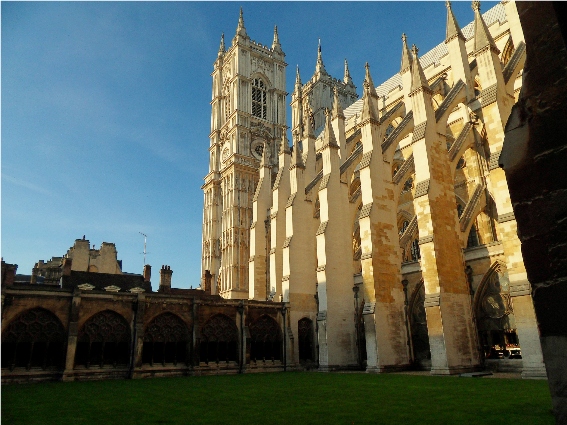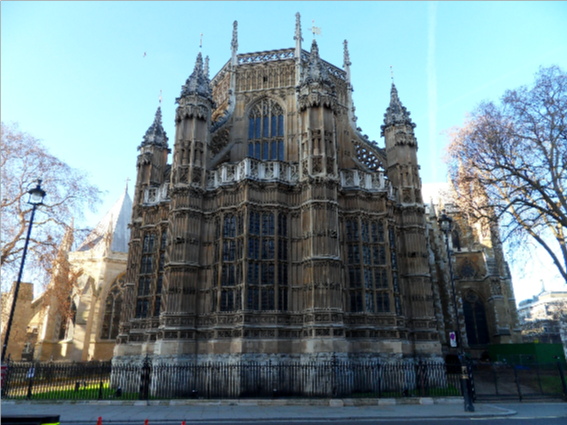Westminster Abbey started as a Benedictine monastery established during the period of 960-980, although it is believed that an abbey - known as St Peters - was founded on the site in the 7th century. Between 1042 and 1052 King Edward the Confessor (1042-1066) began to rebuild and develop the abbey as a royal burial church. Although it was consecrated in 1065 shortly before Edwards’s death, it was not completed until the 1090’s. It was the first church in England to be built in the shape of the cross.
Henry III (1216-1272) started to develop the building in 1245 when he chose it as the place for his burial. Construction took place progressively as Edwards’s church was demolished Henry’s new Gothic building replaced it. At the time of Henry’s death the sanctuary, quire and first bay of the nave had been completed but then work came to a standstill. In 1376 the foundation stone was laid for a new nave, the construction of which took place over 140 years, finally being completed and dedicated in 1516.
Henry VII (1485-1509) added the Lady Chapel where he and his wife, Elizabeth of York are buried; their remains are in a vault beneath their tombs which are located behind the altar and surrounded by a metal grille. Also buried in the chapel is James I (1603- 1625) although he has no monument depicting his resting place. After World War II an altar and window to commemorate the fighter pilots and crew who died during the Battle of Britain in 1940 was added.
Over the years the abbey was the usual place of burial for the Kings and Queens until George II (1727-1760), with the exception of Henry VIII (1509-1547) and Charles I (1625-1649). The burial place of seventeen monarchs the abbey is also the resting place of many distinguished people including many famous musicians, writers and scientists as well as political figures.
The Abbey was also the place of the monarchs’ coronation, this started with William I, the Conqueror (1066-1087) in 1066. Every coronation since 1308 has used King Edward’s Chair which houses the Stone of Scone (also known as the Stone of Destiny). This is a block of red sandstone used for the coronation of Scottish Kings. The stone was captured by Edward I (1272-1307) in 1296 and placed in the chair. The stone was returned to Scotland in 1996 although provision exists for its return for any future coronation: The chair can be seen in the Abbey.
In 1540 Henry VIII (1509-1547) granted the abbey the status of a cathedral but it was to retain that status only until 1550 when it was returned to the Benedictine monks by Mary I (1553-1558). They were however to lose it again in 1579 when Elizabeth I (1558-1603) re-established the abbey as a Royal Peculiar, which is a church that falls directly under the control of the Monarch.
The abbey suffered during the civil war with damage being sustained by the statues, the organ and religious images, although it was protected by Oliver Cromwell during the Commonwealth Period (1649-1659). Cromwell in fact was buried in the Lady Chapel, which is marked by a plaque, although his remains were removed on the restoration of the monarchy in 1660.
At the sides of the aisle of the Lady Chapel are the tombs of Mary I and Elizabeth I who share the same tomb, Elizabeth’s coffin resting on top of that of Mary. On the other side of the aisle is the tomb of Mary Queen of Scots.
The architecture of the abbey underwent a major change between the years of 1722 and 1745 when the two west towers for which the abbey is famous were constructed. The abbey contains some magnificent architecture from its Gothic vaulting with the nave reaching over 31 metres (100 feet) - the highest vault in Britain - to its flying buttresses supporting the exterior of the building and the many tombs and statues. Today the walls look drab but they would have been adorned with brightly coloured paintings. In front of the altar is a mosaic of over 30,000 pieces of porphyry, glass and onyx laid in marble and dating back to 1268.
A visit to the abbey will also take you into the cloister, used by the monks for meditation and exercise and to the museum. The octagonal Chapter house has its original tile floor dating from 1250 and some 14th century murals.
Located by the abbey is St Margaret’s church, built in the late 11th century to enable people to hear mass without disturbing the monks from carrying out their devotions in the abbey. The present church is the third on the site. The second was constructed in the reign of Edward III (1327-1377). The third church was started in 1482 but was not consecrated until 1523. In 1614 it became the church of the House of Commons. It continues to be used for worship and also music recitals. While the abbey itself still plays a significant part in the history and life of the nation.




To see more photographs and take a virtual tour of the site click on the photoshow below.
View in Google Street View and Google Earth
Addition information can be seen on Encyclopaedia Britannica
